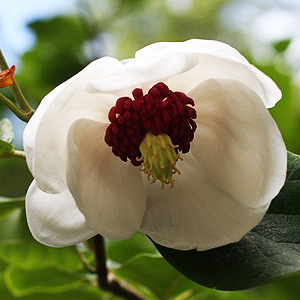Pronunciation: mag-NO-lee-a see-BOLD-ee-eye Magnolia sieboldii

One of the most striking of the deciduous magnolias is Magnolia sieboldii, clear white petals, brilliant deep red stamens and in the centres a touch of buttery yellow.
This is a Chinese species that is grown as a large shrub to small tree with spreading branches and good glossy foliage.
Flowering rather late in the season, the flowers will appear with the foliage in most years, sometimes before.
After the flowers fade, cone shaped fruit appear, however it is the flowers that are the main attraction.
Natural environment
Originally from forested areas of China through to Korea and Japan this is really an understory tree. Also known as the Oyama magnolia as well as Siebolds magnolia.
It is used to dappled shade and a soil augmented by decaying leaf litter.
Fragrance and height
- Fragrance is present however not overly strong.
- This is a tree that can reach 20ft in height, and in good conditions taller. However it is slow growing.
Care
Best grown in a humus rich soil in full sun to part shade. In zones with warmer summer climates, a position where it receives dappled shade in the afternoon is ideal.
Good drainage is essential, depending on the soil ph, a little added lime may be required, look for a ph of around 6. Mulch around the root run to retain moisture during summer months.
Pruning
Deciduous magnolias such as Magnolia sieboldii are not usually pruned. The flowers do tend to hang like pendants so a little height actually makes then look great.
They are best left to a natural growth habit. However as the trees get older, and taller, the flowers are held higher up. So some gardeners can’t resist pruning.
If you must prune, do it immediately after flowering. You will lose flowering for a few years if you prune hard, so if you want a lower growing tree, prune to maintain shape, a little at a time each year.
Zone
Best suited to USDA zones 5 – 9.

